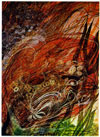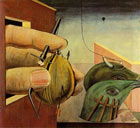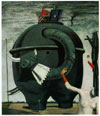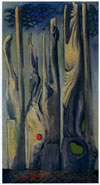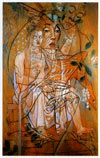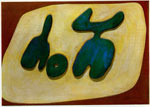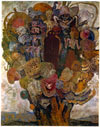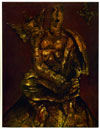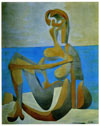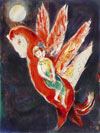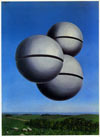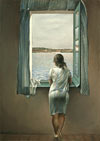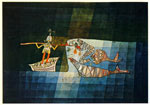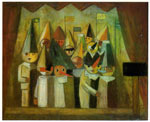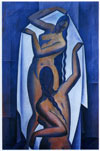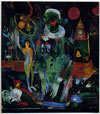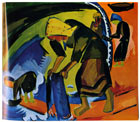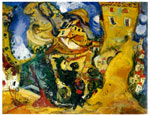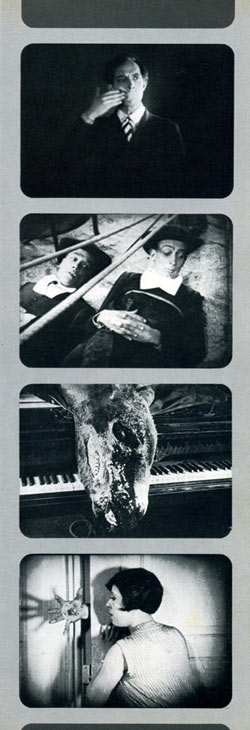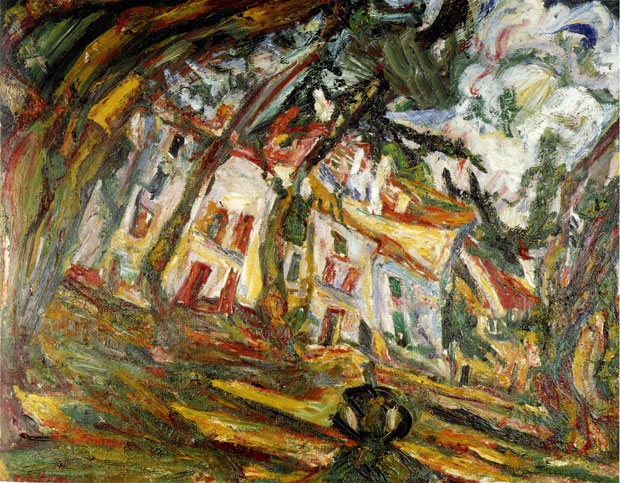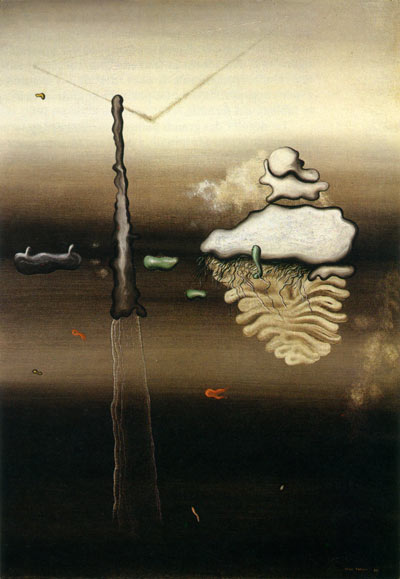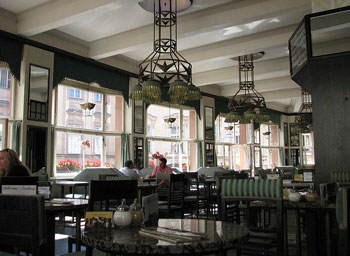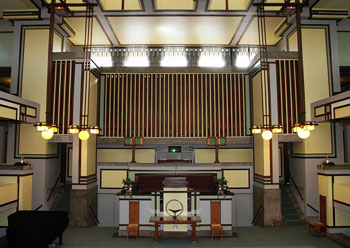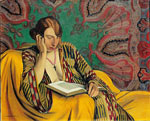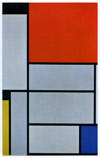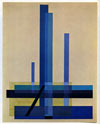
Moving Movements, History of Modern Painting, 1920 - 30
THE YEARS 1920 - 1930
Ludwig Wittgenstein published in 1921 his "Tractatus logico-philosophicus". Wittgenstein is seen as the first logical positivist. In 1925 Niels Bohr and Werner Heisenberg developed the principles of quantum mechanics. In 1927 Heisenberg proposed the uncertainty principle: electrons have no exact location but probability groups of possible locations. In 1928 Philo T. Farnswordth introduced the first completely electronic television, while Vladimir Zworkin got patent on the first colour television.
click the thumbnails
Georgina Houghton
Peinture Automatique
Max Ernst
Oedipus Rex 1922
Max Ernst
L'éléphant des Célèbes 1921
Max Ernst
Forest (frottages) 1925
Joan Miró
The tilled Field 1923-24
Alexander Calder
Mobile 5 1922
Francis Picabia
Minos ca. 1929
Hans Arp,
Plastron, Fourchette
et Nombril 1926
Fritz van den Berghe
Flourishing Tree 1930
Fritz van den Berghe
The singing Statue 1928
Pablo Picasso
Bather at the Coast 1930
Marc Chagall
René Magritte
The voice of the wind 1928
Salvador Dali
Young Girl at the back
Noia d'Esquena 1925
Salvador Dali
The large Masturbator 1929
Paul Klee, War Scene from the comic-fantastic Opera 'The Navigator' 1923
Wassily Kandinsky
Yellow Red Blue 1925
Stanislaw Ignazy Witkiewicz
Felling in the Forest, Struggle ca. 1930?
Tadeusz Makowsky
Children's Theatre 1931
Jar Král
Po Koupeli 1927
Heinrich Campendonk
Pierrot (with Serpent) 1923
Karl Schmidt-Rottluff
Washing Women at Sea 1921
Oskar Schlemmer,
Group of fourteen
in an imaginary Architecture1930
Chaim Soutine
Landscape at Cagnes (La Gaude)
1923
Triumph of Surrealism We
already talked about the necessity of artists to form groups, to capture their principles in an "ism" and place themselves in the "history of modern art". In this way a new group arose around André Breton, who wanted to frame the automatic writing in such an "ism". The name "surrealism" came from a piece of Apollinaire: "Les Mamelles de Tirésias"
('12) witch was subtitled as: "Drame surréaliste". In 1921
the first surrealistic manifest arose: art as expression of spontaneous thoughts or movements, free from reason, without esthetical preference or standard, uncensored. Nevertheless a lot of people worked from without the unconscious, without being united in a group, and not all those artists wanted to join Breton's group. |
Man Ray: "Violon of Ingres" 1924 |
Dali and Bunuel: scenes from the film |
Because an "ism" was regarded to be an indispensable link in the evolution of art, there was also a need for forerunners. In this frame De Chirico, although a figurative painter, was appointed as predecessor, because of the dream effect of his landscapes. But to the annoyance of Breton, and totally unsuited to the idea of evolution in painting, de Chirico had turned his back on this style: namely in 1919, when he had sold only one work on his exhibition in Rome. From that moment he painted horses, myths and legends. Now and then he still made a work in the "old" nostalgic style. Forerunners were also found in literature, with the symbolists, especially "les chants de Maldoror" by Comte de Lautréamont,
a work from the 18th century. In the theatre they praised especially A. Jarry with his
satiric comedy "Ubu Roi" from 1890, the inventor of the science "pataphysica":
"all physical laws are exceptions, which appear a bit more often then others". Soon also Miro joined this group. He was regarded as an abstract painter, because he stylised and reduced the recognisable forms so much they became a kind of symbols, only recognisable to the artist. Under the dictatorship of Breton there was a lot of coming and going in the group. For example Ernst and Miro made décors for the ballet of Diaghilevin in 1926, regarded as the summit of bourgeois. They were expelled by Breton and later rejoined the group. Ernst always managed to keep his individuality as well as his friendship with Breton. |
Arp,
who made wall reliefs in much stylised forms, withdrew from the group in
1928. Calder invented the mobile in '26. Ernst made
in '25 his "frottages". The Belgian Fritz van den Berghe gradually evolved towards surrealism in '26 – '27, as for example in
"Births" of "Awakened Dream ", without ever have been member of Breton's group. Similar to Ernst he experimented with several techniques and structures (thumbnails on the right). Breton saw Picasso also as a surrealist, but this artist had no need to join the group. Indeed Picasso was often surrealistic in that period, as for example "The Kiss " (1925), "Figure" ('27), "Head" ('29), "Figures at the Coast" ('31), and so on. (Click thumbnail on the right.) Also Chagall refused kindly. |
Pablo Picasso, La Femme aux Pigeons, 1930 |
René Magritte, "Miroir Vivant" 1928 |
In 1927 Magritte went to Paris to present his very figurative surrealism, which he had started in '26. Magritte wanted to prove we are not able to see the reality, only an image about the object: "Ceci n'est pas une Pipe". By joining images which normally never appear together, or by placing titles which normally do not suit the object, Magritte wanted to break those patterns of our brains and by doing so open us for the unconscious. But Magritte's works are not a dry intellectualism, they are often very poetic. He also experimented with other things, such as writing words on the canvas, words which call up a landscape in our minds, because we associate each word with a certain image. |
| In 1929 Breton was happy also Dali came to Paris, although Breton already had objections. In 1929 the film from Dali and Bunuel: "Un Chien Andalou", was set. Between '29 and '34 Dali made his smallest and most known works, after he changed form cubism and precise realism to surrealism (thumbnails on the right). Like other surrealists he was interested in the phenomenon of insanity. He praised the "paranoid talent": the capacity to discover more then one reality in one and the same scene. In that way he saw in the "Angelus" by Millet a flood of sexual symbols. Het asserted that the legend of Willem Tell was cannibalistic: the father wanted to eat his son. |
Surrealists Tristan Tzara, Paul Éluard, André Breton, Hans Arp, Salvador Dalí, Yves Tanguy, Max Ernst, René Crevel and Man Ray, Paris 1933 |
Other styles
Felixmüller painted expressionism totally loose from Die Brücke. He painted as an indictment of the war, as Dix and Grosz also did, but also of social exploitation. In 1917 - '18 he was an experimenting cubist, but soon he returned to expressionism, although something of cubism did remain in his work. Near
1925 his style changed.
Paul Klee still painted between the styles of Campendonck, abstract and naive. Müller now painted a very commercial and sentimental kind of expressionism. Heckel changed to goody-goody and powerless work. Also with Kirchner the brush strokes and sharp corners will later make place for quiet, flat colour areas and round flowing contours (for example "Nude in the forest",
1934). He will commit suicide in 1938, when Hitler gave the final blow to what was left of expressionism.
On an international exhibition in 1920 of French and Belgian cubism Permeke's work was hanging. He began to work more sober, often in one colour tone. His canvas became gloomy or in a strong light-darkness contrast, as in romanticism. The figures were kept simple, stylised and formed quickly, the proportions are distorted to serve the expression. He kept working like this until 1951, although he changed with other kinds of style. Leon de Smet changed in 1921 his wonderful impressionism for expressionism, but something of his previous style is kept in his work.
Chaim Soutine, La Place du Village, Céret, ca. 1920 |
In
1919 The Russian Chaim Soutine, emigrated in France, grew to his definite style. Everything is distorted, heavily bend. He plays with perspective laws: a road runs through the canvas as on an air view photo, whereas the houses are seen from the ground (click thumbnail on the bottom). His work became gradually more abstract, one has to watch carefully to notice the figuration. Nature is a criss-cross of bending colour lines, houses are bend surfaces. He works colourful with the technique of several colours mixed and full of movement. |
| He also painted carrions and portraits with twisted faces. Monet was working at his large wall paintings with water lily ponds until he died in '26, and in spite of his cataract problems at his eyes. The figures disappear more and more, until almost abstraction. He worked with thin mixed layers as Turner did, as well as with wild, fast brush strokes on coloured areas. Kandinsky painted in '23 geometric abstract, with sharp contours. In '25 there were already playful transitions, in '36 his work will be playful again, with the surrealistic figures he then reminds Miro. In Poland Pronaszko painted in a cubist style resembling stained glass windows. From about '22 he returned to a style that reminds Degas. Chwistek was painting in a free cubism, he reminds sometimes Matisse. Czyzewski painted in a kind of abstract with figurative elements, as Chagall or Klee did. Waliszewski got a kind of expressionism between Matisse or a careless fauvism. Berlewi worked abstract. Makowski worked expressionist although naive with funny puppets, for example in "Children's Theatre" (31). Cybis was a deliberate naive painter, he made "Primavera" in '36. He was member of the "Saint-Lucas Brotherhood", a group which did go back to Botticelli. He also made ceramics. Also Czech had its cubists, for example Král. There was also cubist architecture and complete cubist interiors were made. |
Yves Tanguy, "Sans Titre", 1928, example of abstract surrealism |
Cubist furniture |
![]() Copyright for the text of all pages of this History of Modern Painting: Johan Framhout; text written in 1990-92; revisionned and put on the internet in 2005; translation in English 2012
Copyright for the text of all pages of this History of Modern Painting: Johan Framhout; text written in 1990-92; revisionned and put on the internet in 2005; translation in English 2012
Praag, Grand Cafe Orient, example of a cubist interior |
Unity Temple Interior, Chicago, Oak Park 1908 |
|
Felice Casorati |
Piet Mondrian |

